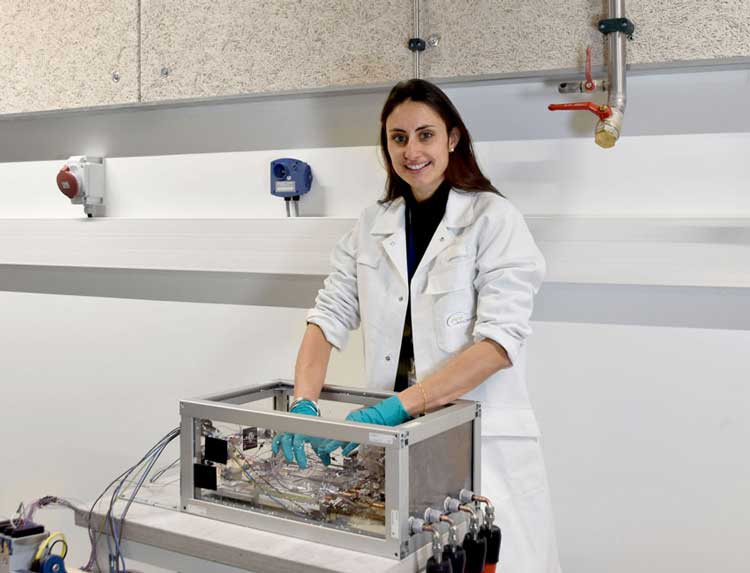IRT Saint Exupéry pursues a series of portraits devoted to the men and women who best represent the institute: its researchers. Their high-level skills and wealth of experience contribute hugely to IRT Saint Exupéry’s performance and unique position, which is so crucial for its members and partners.
Laura Fourgeaud, 29, is a research engineer specialising in fluids and two-phase technology. Laura, who was seconded to IRT Saint Exupéry at 80% by Airbus Defence and Space, is passionate about the experimental approach and the links between basic research and industry.
Can you tell us about your career?
I’m from the Chamonix Valley and love skiing, so my first idea was to become a cable-car engineer! After I finished my studies at ENSEM[1], I joined Poma, a French company based in Grenoble that makes cable cars. This was my first experience of the world of work, and I realised that what I really liked was the time spent doing R&D, trying to get to grips with different phenomena and investigating complex problems.
So, I decided to go back to studying and started a physics PhD thesis. I went to CEA[2] on a Cifre[3] scholarship funded by PSA Peugeot Citroën[4]. My work focused on innovative heat exchangers and pulsating heat pipes (PHPs). It involved trying to understand the behaviour and impact of liquid films that settle on the inner walls of PHPs while they’re in operation. I really liked the experimental side of things and the fundamental aspects of the two areas: hydrodynamics and thermal science. I joined the R&D department at Airbus Defence & Space afterwards before seizing the opportunity two years ago to go on secondment to IRT Saint Exupéry.
What research project are you working on?
I’m working on technologies for cooling electronic systems as part of the SoCool project that IRT Saint Exupéry is devoting to thermal science. We’re developing a cooling loop demonstrator designed to control the temperature of embedded electronic components, which dissipate energy in the form of heat. Our loop is a two-phase heat transfer device that uses capillary pumping. It’s based on the principle of liquid-vapour phase change to evacuate the energy produced by the components. Generally speaking, a loop is used to cool a single component, sometimes called a source. In this case, the idea is to cool several sources with a single loop to gain efficiency and modularity and save weight and space.
SOCOOL PROJECT:
SOLUTIONS FOR COOLING, APPLIED TO EMBEDDED ELECTRONICS IN TRANSPORT
INDUSTRY MEMBERS
AIRBUS DEFENCE & SPACE . EPSILON ALCEN . CALYOS . LIEBHERR . SAFRAN . THALES ALENIA SPACE
ACADEMIC MEMBERS
ICAM[5] . PPRIME INSTITUTE[6] . LAPLACE[7]
We encountered some difficulties during the development stage: triggering the change phase of the fluid contained in the loop – the boiling – is a very difficult physical phenomenon to understand. Many different parameters come into play, such as the type of fluid and its surface tension, or the tube roughness. So, we reached out to scientists via the partnership with the Laplace laboratory and at conferences, like the excellent ICBCHT[8] in 2018 in Japan. Thanks to IRT Saint Exupéry, we had the opportunity to go into the basic research part in more detail. The scientists who have been working on these subjects for a long time had some solutions for us that helped unlock our applied problems and improve the performance of our demonstrator.
What results are the project members expecting?
We have shown that our multi-source loop demonstrator works. The next step is to apply our system to a real set of embedded electronic components. We’ve designed a test bench with several electronic cards borrowed from the aeronautics industry. We hope to be able to plug our system into all the components that dissipate heat using a simple interface. So, to change a card or the cooling system, all you’ll need to do is unplug it. Our cooling system has to help maintain the temperature of the components to ensure their performance levels and service life, which is a major challenge for developing the aircraft of tomorrow. In the near future, we’ll be in a position to transfer our concept and results to the industrial partners, who will adapt the design to suit their needs.
What do you like at IRT Saint Exupéry?
What I like at IRT is that we do a lot of experimental work on the SoCool platform. I’m one of those scientific engineers who thinks that you can’t understand anything if you’re too far removed from the experimental side. The resources are available at IRT, and the technicians, engineers and scientists are very close to each other. It’s really the ideal situation.
And I’ve lots of freedom. I’m free to organise my time. I go to Airbus Defence and Space a few times a week and I involve them as much as possible. I can also teach at ISAE-SUPAERO and ICAM. I like to pass on my knowledge, and training is part of IRT’s missions.
What do you want to share with us?
On the SoCool project, there are equal numbers of boys and girls – four each – which is pretty unusual in the area of fluids and thermal science!
PUBLICATIONS
Article being drafted, 27th French Congress of Thermal Science SFT 2019, Nantes, 2019, June 3-6Experimental investigations of a Multi-Source Loop Heat Pipe for electronics cooling. L. Fourgeaud, R. Mari, V. Dupont, C. Figus, IHPC (Intern. Heat Pipes Conference), Pise (Italy), 2018, June 14-18.
L. Fourgeaud, SFT Technical Seminar on two-phase systems for power electronic thermal control, Toulouse, 2018, March 29 Thermal solutions for embedded systems. L. Fourgeaud, Kyutech, Kyushu (Japan), 2018, March 21, invited seminar
[1] Ecole Nationale Supérieure d’électricité et de Mécanique de Nancy.
[2] The French Alternative Energies and Atomic Energy Commission, Service des Basses Températures, Grenoble.
[3] Industrial agreement for training through research; a PhD thesis funding mechanism that helps companies recruit young doctoral researchers.
[4] Collaboration with the Pprime Institute and University of Poitiers.
[5] Institut catholique d’arts et métiers (Toulouse)
[6] Pprime Institute (research and engineering for transportation and energy, CNRS, ISAE-ENSMA/University of Poitiers)
[7] Laboratory on plasma and conversion of energy (CNRS/INP Toulouse/UT3 Paul Sabatier)
[8] Tenth International Conference on Boiling & Condensation Heat Transfer, March 12-15, 2018, Nagasaki (Japan)
SHARE

